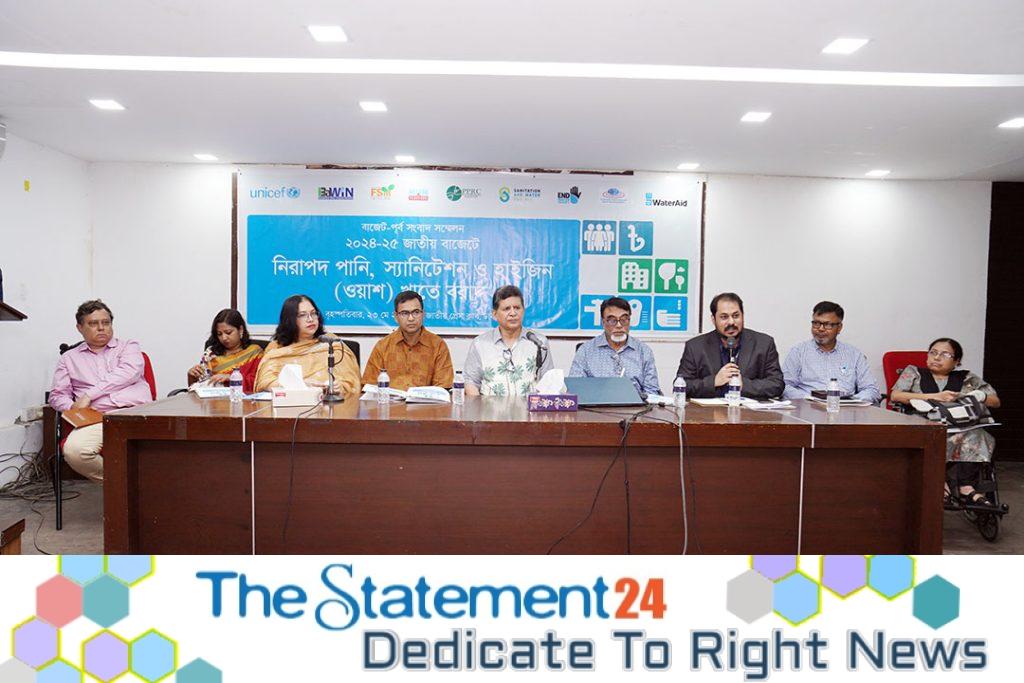
Adequate allocation should be given to water, sanitation, and hygiene (WASH) sector in the national budget for the next financial year 2023-24. Despite the increase in allocation to this sector in recent years, various types of disparities remain. Overall, three types of disparities can be observed in this sector, which should be addressed. Rural-urban disparity, inter-urban disparity and less attention to some areas that are hard to reach especially in the haor areas. All regional disparities in allocation need to be eliminated. Besides, allocation to WASH sector should be proportional to or higher than the size of ADP growth.
In a press conference organized at the National Press Club on Thursday (May 23) mentioned these. Several private organizations including WaterAid, PPRC, FANSA, FSM Network, Sanitation and Water for All jointly organized this press conference. At the press conference Prominent economist and PPRC executive chairman Hossain Zillur Rahman said that the 6th goal of Sustainable Development Goals (SDG) is to ensure safe drinking water and sanitation for all. In order to ensure timely achievement of these targets, the annual development program (ADP) growth rate and allocation to the WASH sector should also be aligned with the development budget.
He said that it is important to give priority to regional disparities and the involvement of the concerned communities in the allocation of ADP in the national budget of the next fiscal year 2024-25. There is a need to address the disparity in distribution between urban and disadvantaged areas under climate risk including Char, Haor, hilly and other hard to reach areas.
Dr. Hossain Zillur Rahman said that the allocation of ADP for WASH sector shows fluctuation and low proportional growth trend. The WASH sector targets in the SDG era are more complex and challenging than the WASH sector in the Millennium Development Goals (MDGs), now emphasizing safe drinking water and safe sanitation.
As of 2021 data, we have met 59% and 39% of these targets respectively. Only 6 years left to achieve SDG6 targets. We not only need to increase allocation to WASH sector but more seriously we need adequate allocation, especially allocation to WASH sector should be proportionate or higher than the size of ADP growth. To protect the environment, he demanded to ensure women, children and disabled-friendly sanitation services in all institutions including public places.
In the press conference, informed that the long-term trend in WASH ADP allocation up to FY2022-23 (Figure 1) shows commendable upward trend though analysis shows that the growth was not proportionate to the rate of increase in the overall ADP size. It is observed that the growth in WASH allocations is only 5.44% which is much less than the 7.4% growth in size of ADP. Such less-than-proportionate growth in WASH allocations is likely to impact negatively on the timely realization of government’s commitment to SDG6.
Thus, the proposed budget of FY2023-24 saw a decline of 23%. Fluctuations in ADP allocation for WASH sector were also observed in FY 2012-13 and FY2013-14. But downward fluctuation in FY2023-24 was almost one-fourth of the allocation in FY2022-23 despite a 11.8% rise in the size of the ADP in FY2023-24 (Taka 2.63 trillion) compared to revised ADP of FY2022-23. Such a budget cut creates difficulties in achieving the targets as well as fulfilling the commitment to providing 100% safe water and 100% safe sanitation.
It may also be mentioned that in FY2022-23 the full budget allocated couldn’t be utilized. The expenditure (FY2022-23) was Taka 124.47, as a result the revised budget was set at Taka 139.63, but that amount was not utilized in full. Similar things happened almost every year. During FY2020-21 due to Covid 19 revised budget was set to Taka 112.32 billion, but utilization was only Taka 70.06 billion only.
Such fluctuation in allocations increases the gaps significantly between growth of WASH proportionately to the growth of GDP, National Budget, and Development Budget that ultimately reflects the gap between urban and rural – from 22.5% in FY 2021-22 to 27.7% in FY 2022-23. The rural-urban gap in WASH allocations broadly continued in allocations for FY2023-24.
It was also informed at the event that growth in WASH allocations (5.44%) has not kept pace with growth in size of ADP (7.4%). Such less-than-proportionate growth in WASH allocations is likely to impact negatively timely realization of government’s commitment to SDG6 and its National Priority Targets (NPTs), i.e., 100% Safe Drinking Water (NPT 17) and 100% Safely Managed Sanitation (NPT 18).
The briefing concluded with the appeal to continue the exemption of Value Added Tax (VAT) and supplementary duty on the import of raw materials of sanitary napkin to encourage domestic production of this very important hygiene product for women and adolescent girls like last 5 (five) financial years since 2019-20.

